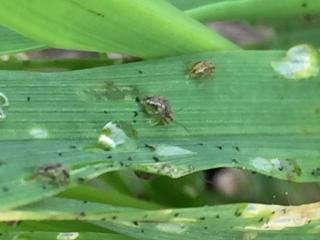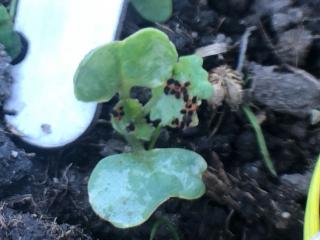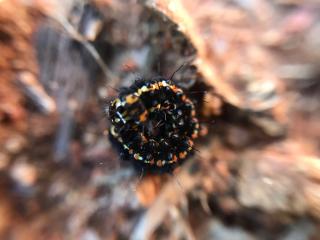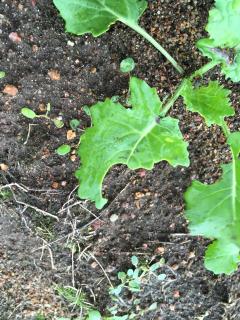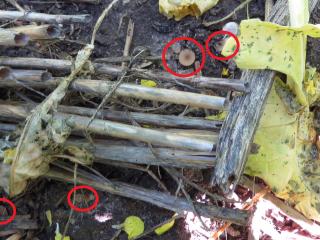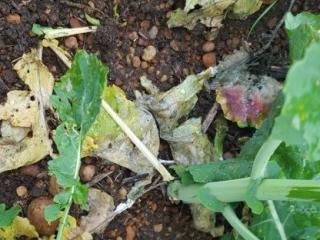Redlegged earth mites and lucerne flea are being found in high numbers in sprayed crops
- Merkanooka/Morawa
- Westdale
- Cadoux
- Dowerin
- Meckering
- Cunderdin
- York
- Beverley
- Brookton
- Narrogin
- Wickepin
- Williams
- Wandering
- Crossman
- Darkan
- Boyup Brook
Redlegged earth mites (RLEM) and lucerne flea continue to damage young crops, and in some cases have escalated in numbers even in crops which have received a pre-sowing and/or post sowing pre-emergence insecticide application.
Farmer Zak Valentine has sprayed his cereal crops at Merkanooka (west Morawa) this week for lucerne flea where they were in high numbers, especially in paddocks which were fallow last year and/or on heavy soils. Zak noted that his canola crops which were sprayed with chlorpyrifos and bifenthrin about 3 weeks ago do not seem to have damaging levels of RLEM.
A farmer at Westdale has reported very high numbers of RLEM in his canola which was sprayed with 80 mL of Talstar® (bifenthrin 250 g/L) presowing and a second application of 40 mL/ha Talstar® post sowing in early June. The paddock was in barley last year and the farmer will spray chlorpyrifos now to protect the crop.
Research officer Pip Payne (DPIRD) has found lucerne flea feeding on oats at an oat trial site near Cunderdin. The site will be sprayed with Le-Mat® to prevent further damage.
David Stead (Anasazi Agronomy) is seeing RLEM and lucerne flea in high numbers in cereal and canola crops from Cadoux through down to Brookton. David said more than 50 RLEM per plant are not hard to find. David was also concerned that crops had been sprayed one or more times so far and the insecticides were not controlling populations. Interestingly, Dave noted that very high numbers tended to be in crops that were in fallow or pasture last year, but also that growers that used a Timerite® spray in spring last year usually had reduced numbers of RLEM.
Hilary Wittwer (Planfarm) has also recently seen high numbers of RLEM and lucerne flea in cereal and canola crops near Narrogin, Wickepin, Williams and Wandering. Hilary commented that crops are very wet and some are currently impossible to get a boom spray onto.
An Agworld user has reported finding RLEM in oats near Crossman.
Jessica Brown (Kalyx) reports that RLEM and lucerne flea were damaging canola at Darkan.
Ben Creek (AGRIvise) has reported that cotyledon to 8 leaf canola crops in the Boyup Brook area are being damaged by RLEM and vegetable weevils. Lucerne flea are also a problem in the Boyup Brook area especially in clover paddocks and canola crops that have had late and staggered germination.
Why is this happening?
Late season starts like this are frustrating for pest management because the late rains, slow plant germination and delayed mite and lucerne flea egg hatchings mean that the usual tactics of tank mixing insecticide with herbicide do not control the mite and lucerne flea populations.
RLEM and lucerne flea can also hatch outside of the window of insecticide efficacy.
Heavy rains can also affect the efficacy of spays.
This combination of factors often results in high to sometimes very high numbers of RLEM and/or lucerne flea in crops at this time of year when sprays applied weeks ago are no longer effective enough to bring those populations down.
Adding to the frustration is that some populations of RLEM in WA have developed resistance to the commonly used synthetic pyrethroids (SP’s; e.g. Talstar®) and organophosphates (e.g. Le-Mat®). However, in most cases where RLEM and lucerne flea are surviving sprays they are simply not coming into contact with a lethal dose of insecticide because of the spray choice, spray date relative to egg hatch, and other agronomic conditions including heavy rain.
It is also worth noting that lucerne flea do not respond well to SP’s so this is sometimes why lucerne flea are surviving and damaging crops after an SP spray.
Both RLEM and Lucerne flea will attack all crop and pasture species, however lucerne flea tend to damage cereals more than RLEM.
For insecticide recommendations for managing lucerne flea and RLEM refer to DPIRD’s 2019 Autumn/Winter Insecticide Guide.
Testing available for insecticide resistance in redlegged earth mite
Growers who notice reduced chemical efficacy or suspect insecticide resistance in RLEM are now able to test for resistance.
DPIRD is again making available a screening service to growers and consultants to test for insecticide resistance in RLEM, following previous screening in 2017.
The free-of-charge service, made possible with investment by the Grains Research and Development Corporation (GRDC), is led by The University of Melbourne, in collaboration with DPIRD, cesar, and CSIRO.
Growers who find RLEM that survive registered rates of insecticide treatments are encouraged to arrange for resistance testing to be conducted by contacting DPIRD entomologist Svetlana Micic, Albany on +61 (0)8 9892 8591 or 0427 772 051.
For more information refer to GRDC’s RLEM Resistance Management Strategy, and the IPM Guidelines for Grains website.
For more information about diagnosing and managing RLEM and lucerne flea refer to DPIRD’s Diagnosing redlegged earth mite and Diagnosing lucerne flea pages.
For more information on invertebrate insects contact Dustin Severtson, Development Officer, Northam on +61 (0)8 9690 2160 or Svetlana Micic, Research Officer, Albany on +61 (0)8 9892 8591 or Alan Lord, Technical Officer, South Perth on +61 (0)8 9368 3758.
Weevils and caterpillars can be sneaky
Pasture day moth caterpillars
- Mullewa
A Planfarm agronomist recently found pasture day moth caterpillars damaging a seedling wheat crop near Mullewa.
Pasture day moth larvae are dark brown with yellow and reddish orange markings. They have two prominent yellow spots near the end of the body and an orange-black head. Pasture day moth caterpillars remain on plants during the day.
Pasture day moth caterpillars are not usually considered a pest as they prefer to feed on capeweed, erodium and other broadleaved weeds.
Pasture day moth caterpillars are easily controlled by insecticides.
For more information pasture day moths refer to DPIRD’s Diagnosing pasture day moth damage page.
Canola weevils
- Beverley
- Boyup Brook
Hilary Wittwer (Planfarm) has found leaf damage to a 2-5 leaf canola crop west of Beverley. The culprit could not be found so pitfall traps have been put in the ground to see if weevils are present. There didn’t seem to be new damage to leaves which could indicate that that caterpillars have fed, pupated and emerged as moths and flown away.
Ben Creek (AGRIvise) has reported that vegetable weevils are damaging canola crops ranging from cotyledon to 7-8 leaf stage around Boyup Brook.
Vegetable weevils are about 10mm long with two short white stripes at an angle on each side of its abdomen. They are often camouflaged amongst stubble and trash and tend to hide during the day. Sections of cotyledons or leaves missing (often in patches) are a good indication of weevils or small caterpillars.
They may be confused with two other common weevil pests of crops and pastures: the spotted vegetable weevil (or desiantha weevil; 5mm) and the small lucerne weevil (10mm). Importantly, the vegetable weevil requires higher rates of insecticides than most pests of canola. For more information see DPIRD’s 2019 Autumn Winter Insecticide Guide.
For more information on weevils visit DPIRD's Diagnosing weevils in canola page.
Tools to help diagnose insects in crops
If you can manage to find an insect while inspecting a damaged area of crop and you are not sure what it is use the free PestFax Reporter app and take some photos, attach them to your report and request a diagnosis or select unknown for the pest. The PestFax team wants to know what invertebrate insects you are finding in your crops and pastures, whether it is a pest, beneficial or unknown. We even want reports of the usual insects that are seen every season.
You can also consider trying the free, easy to use grain pest identification field guide for Android and iPhone devices called MyPestGuide Crops. The app quickly identifies crop pests by filtering information on the damage or pest description and runs outside mobile range. There is also an app for identification of crop diseases called MyPestGuide Diseases.
For more information contact Dusty Severtson, Development Officer, Northam on +61 (0)8 9690 2160 or Alan Lord, Technical Officer, South Perth on +61 (0)8 9368 3758.
Sclerotinia apothecia are being found
- Geraldton
DPIRD officers Ciara Beard and Anne Smith have reported finding a sclerotinia apothecia this week at Geraldton. It was found under advanced wheat plants. This is the first report for this season and follows substantial weekly rainfall at the site since the season break in early June.
This finding is a warning that the sclerotinia disease cycle is commencing in the northern wheatbelt.
Plant pathologist Ravjit Khangura (DPIRD) has also reported finding sclerotinia apothecia in her backyard, near bottle gourd affected by sclerotinia, in the Perth metropolitan area.
Apothecia are little cream coloured mushrooms measuring 5-15mm in diameter that appear after carpogenic germination of sclerotes (hard black fruiting bodies/resting structures of sclerotinia) under favourable conditions. Apothecia release massive amounts of ascospores that cause sclerotinia stem rot predominantly via infecting petals in all broadleaf crops including canola, lupins, chickpeas, lentils, field peas, faba beans, lucerne and weeds (wild radish and cape weed).
Growers are urged to start planning for sclerotinia management in their canola crops.
Despite dry start to the season, weather conditions seem to be favourable for sclerotinia spore release in some parts of the grainbelt and therefore elevating the risk for disease outbreaks in flowering canola.
DPIRD research over the past few years has shown that as a rule of thumb regular rainfall and high humidity (>75%) in the three weeks before and after commencement of flowering are most conducive for the damaging levels of disease to occur in crops. Although canola crops are at variable growth stages in the state, the most vulnerable canola crops are the ones that have just started to flower or are flowering as infected petals dropping onto plants initiate infections. These may require fungicide protection.
Growers need to consider the following risk factors:
- rotation history of the paddock
- history of sclerotinia in the current canola and surrounding paddocks
- rainfall events before and after flowering
- growth stage of canola.
In Western Australia, two pathways of sclerotinia infection have been reported. The most common infection pathway is via infected petals, however, basal infections pre-flowering have been frequently observed in some years particularly under very wet conditions in paddocks that have high inoculum levels. Basal stem infections can develop from dying leaves that touch the ground or direct growth to the stem over/under the soil from sclerotia. White masses that are fungal hyphae (on leaves, soil or stem bases) are the key symptom to look for.
Growers and consultants are advised to assess their risk of sclerotinia and be prepared to apply fungicide if the risk is moderate to high. Growers also need to keep an eye out for basal sclerotinia infections in high risk paddocks. Download the free app SclerotiniaCM app to aid in fungicide decision making.
Several fungicide products that are made up of the active ingredients prothioconazole + tebuconazole, procymidone, iprodione and more recently prothioconazole + bixafen are registered for the control of sclerotinia in canola. Fungicides need to be applied as recommended per product label.
Based on the extensive research conducted by DPIRD over the last few years the following in-season sclerotinia management options are recommended;
- Apply a single foliar application at 30-50% bloom, provided conditions are favourable for infection before and during flowering. See Table 1 below for recognising bloom stages in canola.
- A second fungicide application at 50% (full) bloom is only beneficial in seasons with an extended wet period.
- If growers notice ground infections they can apply a foliar fungicide immediately or wait until 20% bloom to prevent further new infections.
- Fungicide application is still warranted in crops with wide row spacing (up to 44cm) if the seasonal conditions (high rainfall and humidity) become favourable during flowering.
| Percent bloom | Number of flowers open on the main stem |
|---|---|
| 5% | <5 |
| 10% | 10 |
| 20% (petal drop commences) | 11-14 |
| 30% | 15-20 |
| 50% | >20 |
Growers and consultants are encouraged to report to the PestFax service any apothecia finds or disease observations as the season progresses.
Further information can be found at the department’s Managing sclerotinia stem rot in canola page and GRDC’s Sclerotinia stem rot in canola factsheet.
For more information on sclerotinia contact plant pathologists Ciara Beard, Geraldton on +61 (0)8 9956 8504, Ravjit Khangura, South Perth on +61 (0)8 9368 3374 or Andrea Hills, Esperance on +61 (0)8 9083 1144.

